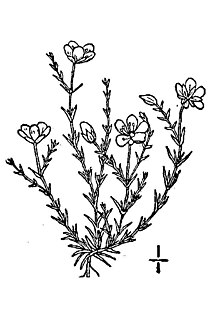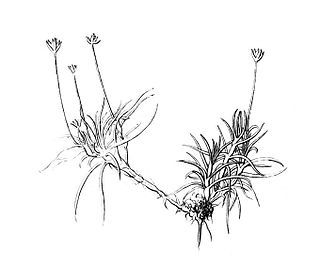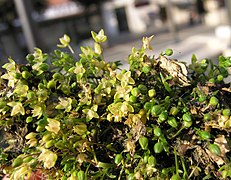
Caryophyllaceae, commonly called the pink family or carnation family, is a family of flowering plants. It is included in the dicotyledon order Caryophyllales in the APG III system, alongside 33 other families, including Amaranthaceae, Cactaceae, and Polygonaceae. It is a large family, with 81 genera and about 2,625 known species.

The Caha Mountains are a range of low sandstone mountains situated on the Beara peninsula in south-west County Cork, in Ireland. The highest peak is Hungry Hill, 685 m (2,247 ft) tall. Other notable peaks include Knocknagree, Sugarloaf Mountain, Eskatarriff, Knocknaveacal, Derryclancy, Nareera, Killane Mountain and Baurearagh Mountain.

Sagina nodosa, the knotted pearlwort, is a species in the genus Sagina, native to northern Europe. It is a low-growing plant up to 15 cm tall, with paired leaves up to 1 cm long. The flowers are 5–10 mm diameter, with five white petals.

Colobanthus is a large genus of small, cushion-like herbaceous plants in the family Caryophyllaceae, sometimes known as "pearlworts", a name they share with plants of the related genus Sagina. C. quitensis is the world's southernmost dicot, and one of only two native extant flowering plants of Antarctica.
Pearlwort is a common name for several plants and may refer to:

Sagina subulata (, the heath pearlwort, Irish-moss, awl-leaf pearlwort or Scottish moss, is a species of flowering plant in the pink and carnation family Caryophyllaceae. It is native to Europe, from Iceland south to Spain, and east to southern Sweden and Romania. It occurs on dry sandy or gravelly soils.
Saint Helena, Ascension Island and Tristan da Cunha, as well the other uninhabited islands nearby, are a haven for wildlife in the middle of the Atlantic Ocean. The islands are or were home to much endemic flora and fauna, especially invertebrates, and many endemic fish species found in the reef ecosystems off the islands. The islands have been identified by BirdLife International as Important Bird Areas for both their endemic landbirds and breeding seabirds.
NVC community CG10 is one of the calcicolous grassland communities in the British National Vegetation Classification system. Of the upland group of calcicolous grasslands, it is the only one with a short sward associated with heavy grazing.
British NVC community OV20 is one of the open habitat communities in the British National Vegetation Classification system. It is one of six communities characteristic of gateways, tracksides and courtyards.

Sagina is a genus of 20–30 species of flowering plants in the family Caryophyllaceae. These are flowering herbs native to temperate regions of the Northern Hemisphere extending south to tropical mountain areas at high altitudes, reaching just south of the equator in Africa. They are small annual or perennial herbaceous plants, growing to 5–15 cm. The leaves are opposite, often in tight whorl-like clusters, simple linear, typically 5–20 mm long. The flowers are solitary or in small cymes, with four or five green sepals and an equal number of white petals; the petal size relative to the sepal size is useful in species identification. The fruit is a small capsule containing several seeds.

Sagina apetala is a species of flowering plant in the family Caryophyllaceae known by the common names annual pearlwort and dwarf pearlwort. It is native to Europe and it is known elsewhere as an introduced species, including parts of North America. It grows in many types of disturbed habitat, such as cracks in the sidewalk. It is a petite annual herb producing a threadlike stem just a few centimeters long, spreading or growing erect. The plant is glandular and somewhat hairy. The leaves are linear in shape and not more than about a centimeter long. The inflorescence is a solitary flower borne on a threadlike pedicel. The flower has usually four sepals and generally no petals.
Sagina decumbens is a species of flowering plant in the family Caryophyllaceae known by the common names trailing pearlwort and western pearlwort. It is native to several areas of North America, where it can be found in many types of habitat. It is a small annual herb producing a threadlike green or purplish stem growing erect or trailing, measuring up to about 16 centimeters long. The leaves are hairless, linear in shape, and one half to two centimeters long. The inflorescence is a solitary flower borne on a threadlike pedicel. The flower has usually five sepals and five tiny white petals. There are two subspecies which differ mainly in the microscopic appearance of the seeds.
Sagina maxima is a species of flowering plant in the family Caryophyllaceae known by the common names stickystem pearlwort and thick-stemmed pearlwort. It is native to the west coast of North America from Alaska to California, where it can be found in many types of sandy and rocky coastal habitat. It is a small, fleshy perennial herb growing in a clump of linear leaves and thick stems. The fleshy, pointed leaves are 1 or 2 centimeters long. The inflorescence is a solitary flower with five sepals and five small white petals. There are two subspecies which differ mainly in the arrangement of hairs on the stem.

Sagina procumbens is a species of flowering plant. in the family Caryophyllaceae known by the common names procumbent pearlwort, birdeye pearlwort and matted pearlwort. It can be found throughout the Northern Hemisphere and parts of South America. It is a common weed of many environments. It can be found in wild and disturbed habitat, especially moist areas. It can sometimes be seen growing in lawns or in cracks in the sidewalk. This is a perennial herb forming clumps or mats of hairless green herbage, sometimes vaguely resembling a patch of moss. The leaves are linear and up to 1 or 2 centimeters long. The inflorescence is a solitary flower with four or five sepals and four or five small white petals, but the petals are sometimes absent.

Sagina saginoides is a species of flowering plant in the family Caryophyllaceae known by the common names arctic pearlwort or alpine pearlwort. It has a circumboreal distribution; it can be found throughout the northern latitudes of the Northern Hemisphere. It grows in subalpine and alpine climates and other mountainous habitat at lower elevations. This is a small perennial herb producing a slender to threadlike stem just a few centimetres long, growing decumbent or erect. It is sometimes clumpy in form. The leaves are linear in shape and about 1 to 2 centimetres in length. The inflorescence is a solitary flower with five sepals and five small white petals.

"And Can It Be That I Should Gain?" is a Christian hymn written by Charles Wesley in 1738 to celebrate his conversion, which he regarded as having taken place on 21 May of that year. The hymn celebrates personal salvation through the death and resurrection of Jesus, and is one of the most popular Methodist hymns today.

The Osmussaare landscape reserve is situated in Lääne County Noarootsi Parish on the island of Osmussaar, Estonia. Its size is 489 ha. The reserve is part of the Natura 2000 network. The reserve was created in 1996 in order to protect rare and scientifically valuable geological objects and plant communities. The reserve is also important for bird migration and lies within the Nõva-Osmussaar Important Bird Area.
Brada Hill is a small hill escarpment near the coast of north Northumberland in North East England, designated as a Site of Special Scientific Interest (SSSI). The 2.4 hectares site is an outcropping of a local stone group, the Whin Sill, on which grows a range of flora representative of the thin, drought-prone soil conditions and influenced by the underlying geology.














